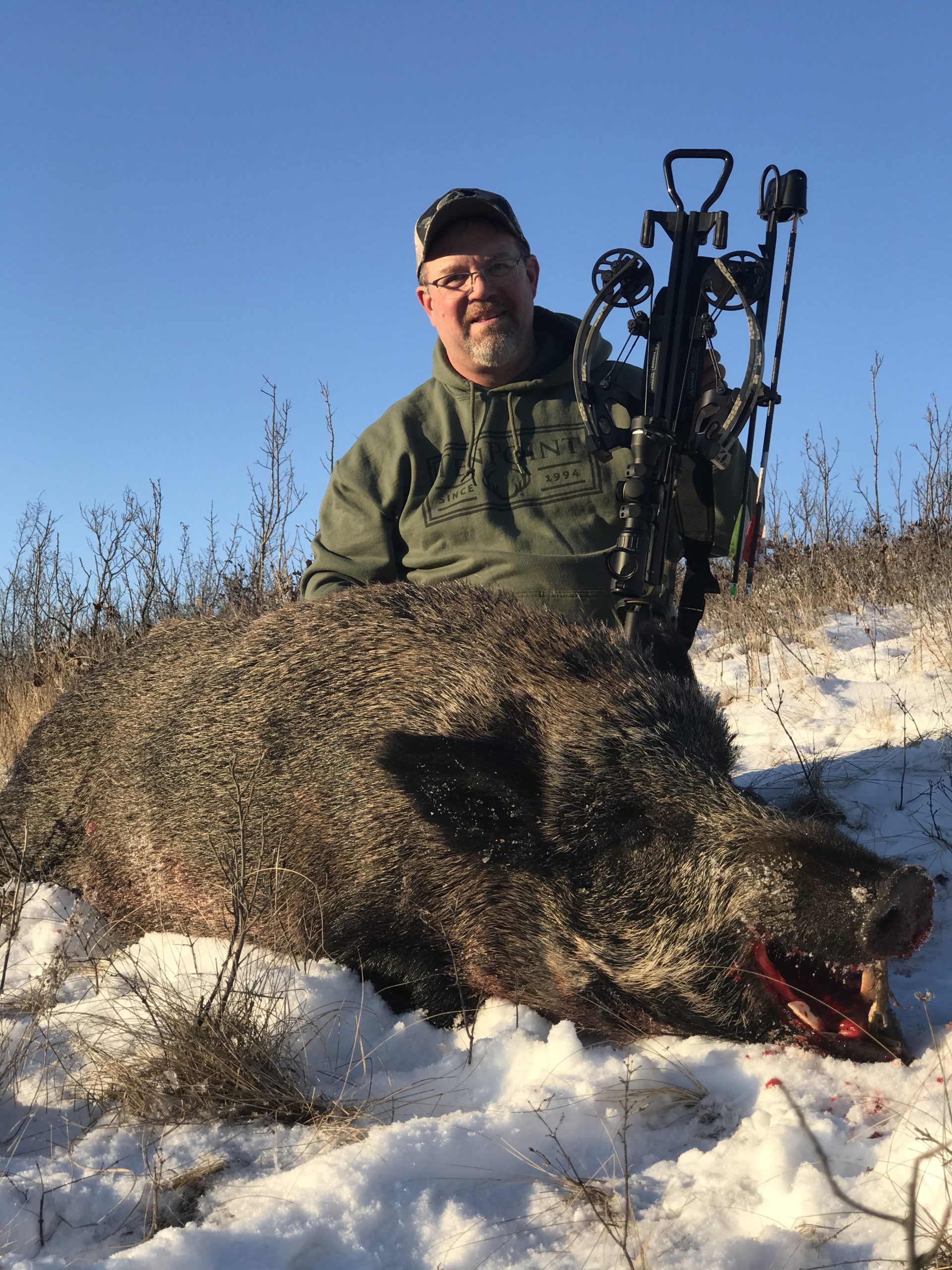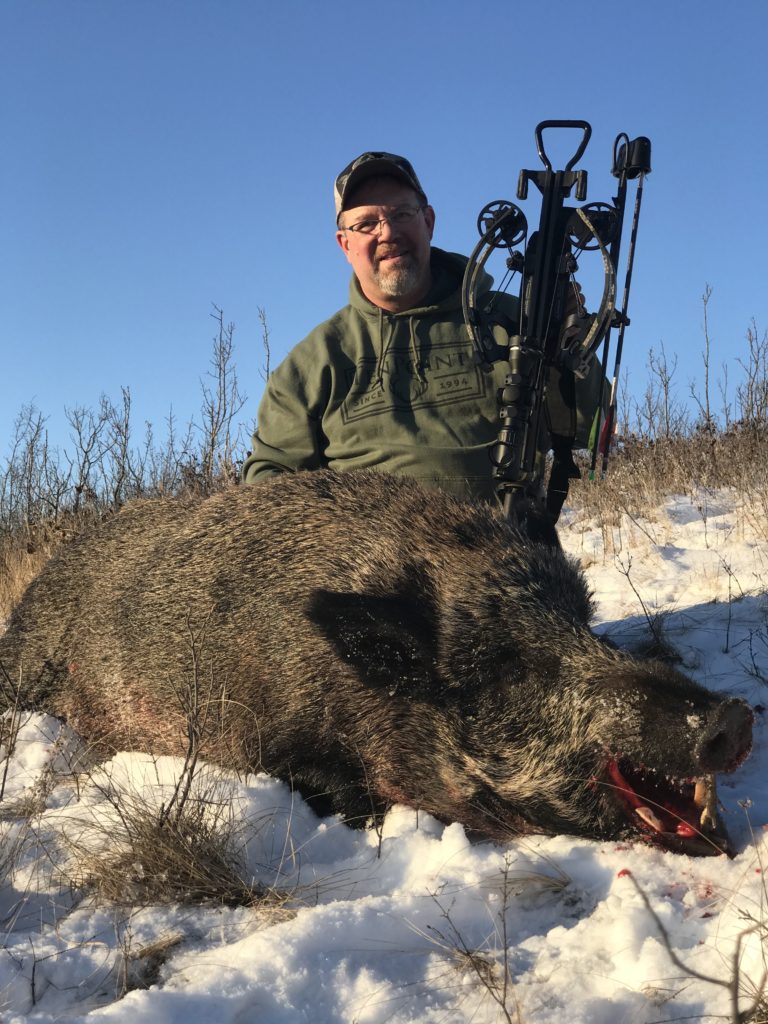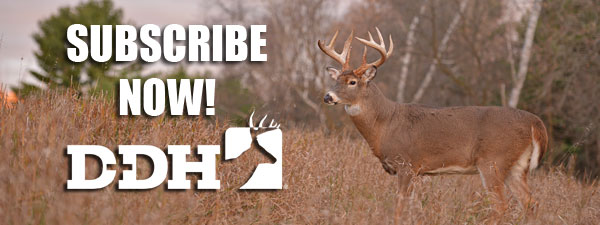Staring at the dark spot across the valley several times, I was convinced it was a Russian wild boar, but every time I put my binocular on it, I changed my mind. The dark outline was just too large to be a hog, but curiosity finally got the best of me.
Hunting with my son Cameron, we got the wind in our face and stalked toward the small scrubby trees. Less than 10 yards away, I was expecting to see a dead tree, or dark patch of ground, as nothing had moved or made a sound. The wind swirled, and I could feel it brush the back of my neck. The small patch of shrubs exploded into a screaming sounder of wild hogs that had bedded together to share warmth.
A big boar ran past me at six yards, and two more exited out the far side of the trees. I looked back at the nest the group of hogs been sharing, and a massive boar was standing and trying to figure out what was happening. I shouldered my TenPoint Vapor RS470 and found the massive hulk of a hog in the scope. The boar was about 25 yards away, and as it stepped forward, a clear shooting lane opened. The pig was at an extremely steep quartering away position. I held the crosshair on the animal’s flank and estimated the travel path of the arrow would see it exit just in front of the far shoulder.
Slowly squeezing the trigger, the SEVR broadhead made a resounding “whack” as it found its mark. The big, old boar jumped and ran, but within seconds the surroundings fell silent. The pig was much bigger than I ever anticipated, and the shot angle would mean the arrow would travel almost the entire length of the solid boar.
We cautiously moved forward and less than 12 yards from where the boar had been standing when the arrow hit him, it was lying dead. I moved to the front of the animal and could not believe my eyes. The arrow had traveled the entire length of the hog and had exited just under the animal’s chin. A good ten inches of the arrow was hanging out with the broadhead, fully deployed, gleaming in the winter sun. We later put the hog on a scale, and it weighed just over 300 pounds, which meant the arrow had unbelievable energy and penetration.
Speed vs. Silence
The new crossbows on the market provide incredible speed and accuracy. Hunters could consider giving up some speed in favor of better penetration and silence. Speed ratings for crossbows are developed by shooting lightweight carbon arrows. The carbon arrows are forgiving and resilient, never losing form or structure.
Why Shoot More Weight?
Projectile weight plays several essential roles in the performance of any bow. A heavier arrow and broadhead will dampen the noise of a crossbow. Lightweight hunting arrows may fly fast, but they also produce more noise from the bow. Weight plays a critical role in kinetic energy and penetration of an arrow and broadhead. There are situations when increased weight provides the best performance. Using a heavier broadhead increases the front-of center (FOC) weight distribution, stabilizing arrow flight.
Even in unsuspecting situations, weight and increased kinetic energy can be a crossbow hunter’s best friend. The hunter who thinks their situation does not require increased energy could have a problem down the line.
Many whitetail hunters set up a treestand and have shooting lanes to 20 or 30 yards. A lightweight arrow and broadhead would be suitable, or would it? Deer don’t always present the perfect shot angle, and hunters don’t always place their arrow where it should be. When there are angles, bone, or concerns with deer jumping the string, a heavier arrow and broadhead will make the difference.
It All Adds Up
Working with Easton Archery, we played with arrow weight by looking at all the components. Aluminum inserts weighing 40 grains were replaced with brass ones weighing 100 grains. We used an Easton Carbon Bloodline, weighing 10.5 grains per inch, and inserted a small diameter carbon arrow inside. With an Alpha nock, NAP Quick Spin fletching, and a heavy 150-grain broadhead, the final arrow weighed just shy of 700 grains. Shooting both arrows and using a smartphone app to measure the decibels produced precise results.
The logarithmic decibel scale has a higher factor of measure as it goes up in powers of ten. That means every increase of 10 dB on the scale is equivalent to a 10-fold increase in sound intensity.
Measuring the decibels shows a definite advantage of heavy arrows in making your crossbow quiet.
The Nitro XRT shooting the 451-grain arrow produced a decibel reading of 95.1 dB, where the 682-grain arrow produced 91.1 dB. With the logarithmic decibel scale, the lighter arrow was almost five times louder coming off the rail. That is a significant difference in noise dampened by the arrow and broadhead by adding weight.
Do the Math
The first thing anyone will notice is the stability of the arrow in flight. The heavyweight arrow was shot out of a TenPoint Nitro XRT. The point of impact on a 20- and the 30-yard target was an eye-opener, falling just two inches lower than with the 451-grain arrow. A minor adjustment on the scope brought the point of impact to the bull’s eye.
Equation
Kinetic energy is the energy an object has owing to its motion. The kinetic energy of an arrow (KEarrow) is equal to the arrow’s weight (grains) multiplied by the arrow’s velocity, squared (fps2), divided by a constant (450,800). For example, if an arrow with a mass of 370 grains is moving at a velocity of 430 fps, the kinetic energy is equal to 152 ft.lbs.
KEarrow = 370*430*430* = 151.8
450,800
Our heavyweight arrow was shot at close to 380 fps with a 682-grain arrow, producing 218 ft. lbs. The energy factor was exceptional, and the arrow was still flying at speeds most crossbows cannot achieve.
Easy Choice
Hunters wanting to reduce the chance of having a deer jump the string, and ensure maximum penetration, need to add weight to their hunting arrow.
An Easton Full Metal Jacket is an excellent choice for increasing the weight and reducing friction for a hunting arrow. The easiest way to add weight, even with the current arrows being used, is to increase the grains of your broadhead. A 150-grain head will increase the weight forward distribution of your hunting arrow, improving flight, reducing sound, and increasing kinetic energy and penetration. It is the quickest way to achieve a technical advantage for any crossbow hunter.
SEVR Robusto Has the Weight and Much More
The New SEVR™ Robusto™ 2.0, 150-grain broadhead was designed specifically with crossbow in mind. The rear-deploy locking-pivoting blade technology, and fluted, hardened-steel ferrule design, will perform with any modern high-energy crossbow. Robusto™ is assembled with a machined one-piece ferrule and precision-ground tip.
The 2-inch cut diameter, with Max-Cut 2.0 blade technology will improve penetration and provide stretch-cut entry and exit wounds for well-defined blood trails. SEVR’s Stretch Cut™ blade will stretch the hide on impact, and cut wounds larger than the blade itself. Some hunters refer to this as a slap-cut.
SEVR’s Lock-and-Pivot™ blades lock open on impact, but the blades can pivot as needed when hitting bone or other dense body parts. The forward pivot works with the acceleration instead of against it to keep the blades in position and closed during the shot through the rapid flight to the target.
SEVR designed a Practice Lock™ screw that can be placed into the broadhead that keeps the blades locked and contained. The lock screw allows hunters to practice with the actual broadheads used to hunt without dulling blades. Remove the lock screw after practice and head to your treestand.
SEVR Robusto 2.0 broadheads are available in 150 grains in standard 8-32 threads. SEVR broadheads are available at www.sevrbroadheads.com/?ref=21.
— PAID PARTNER CONTENT. This content is brought to you by a D&DH advertising sponsor.



